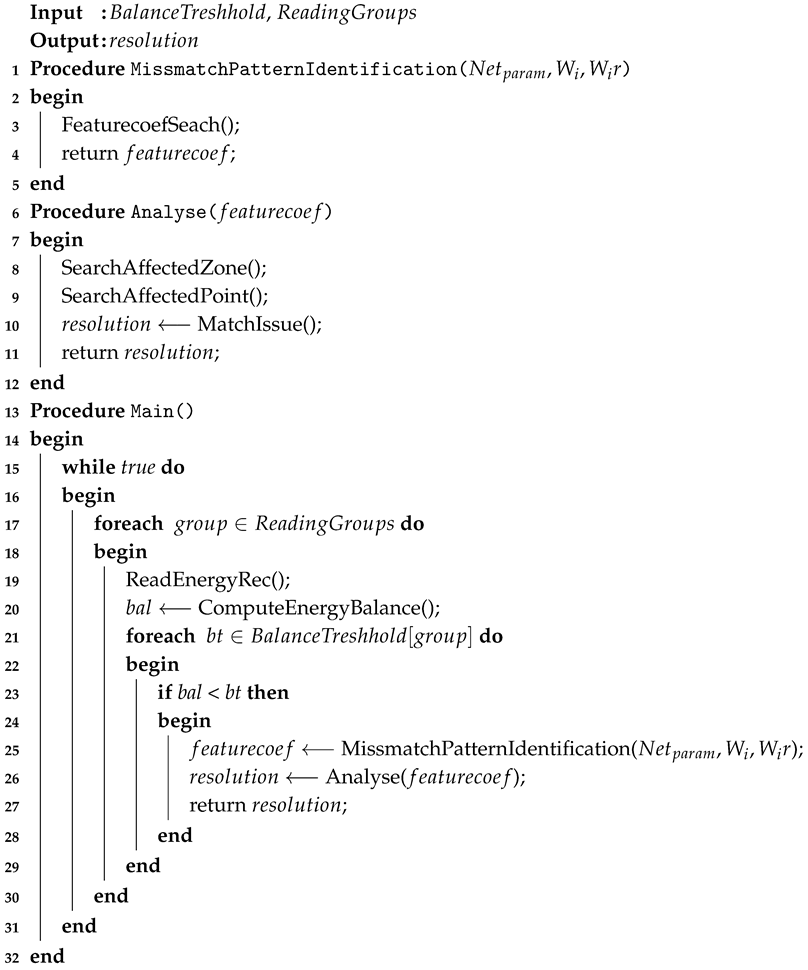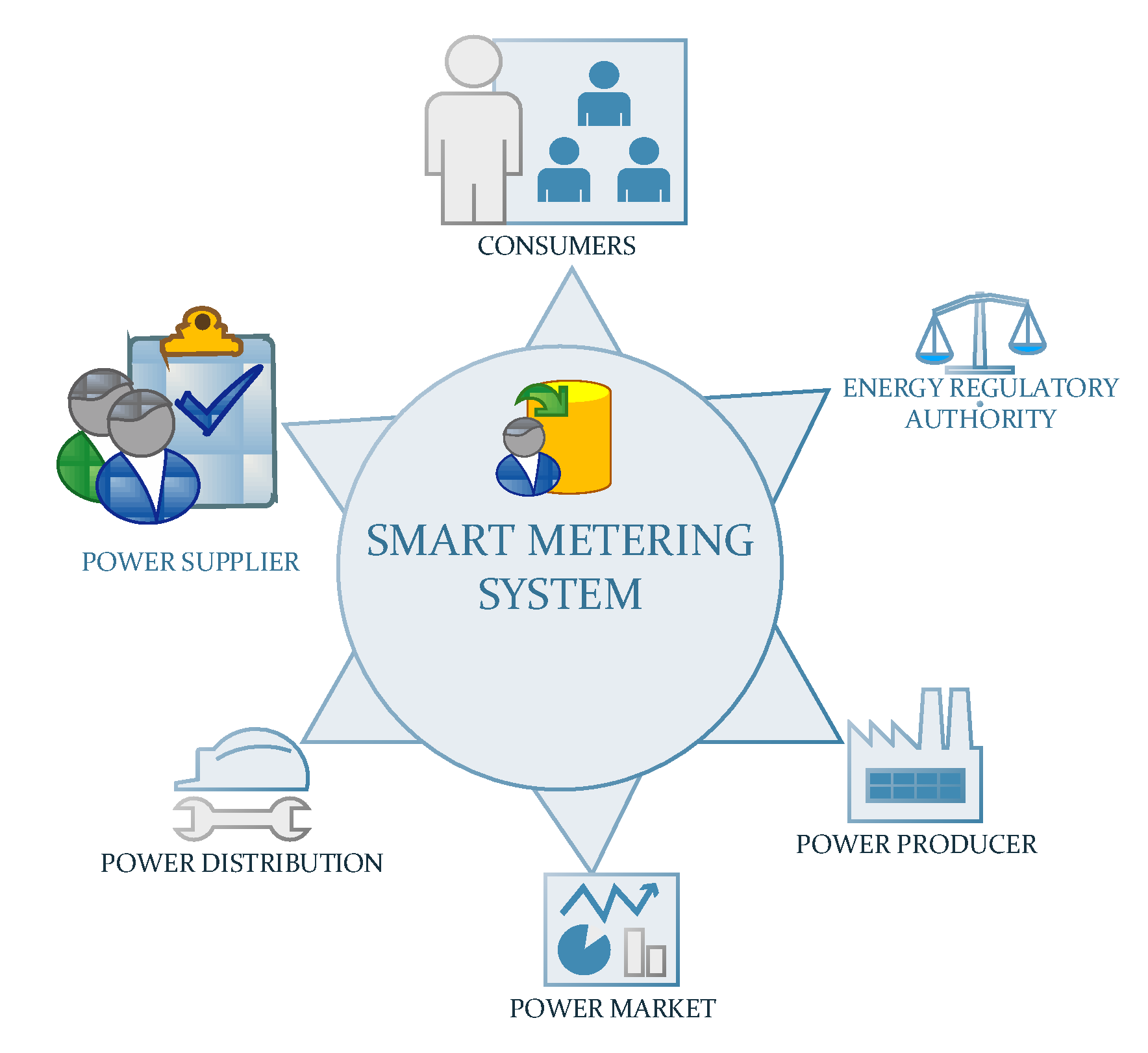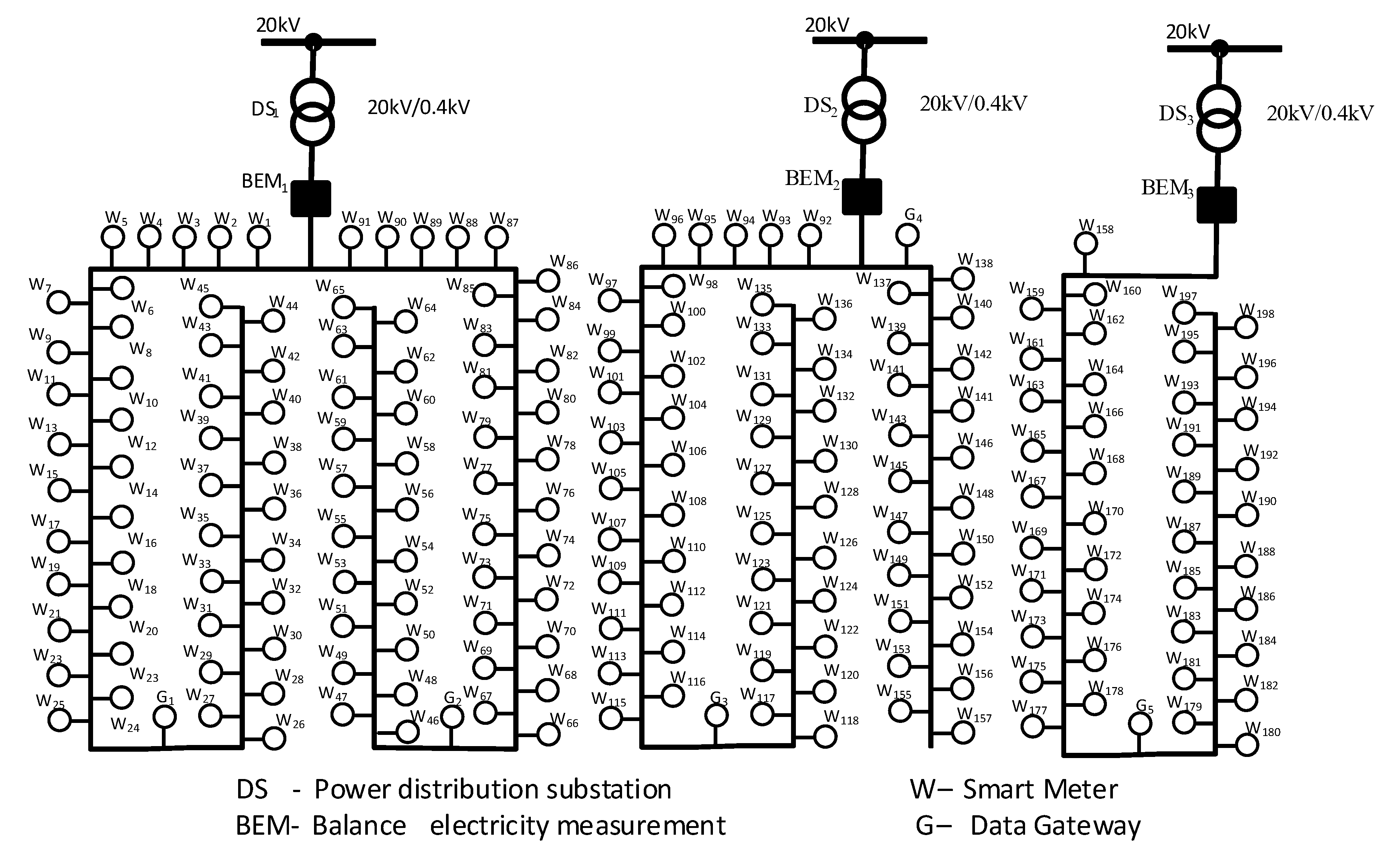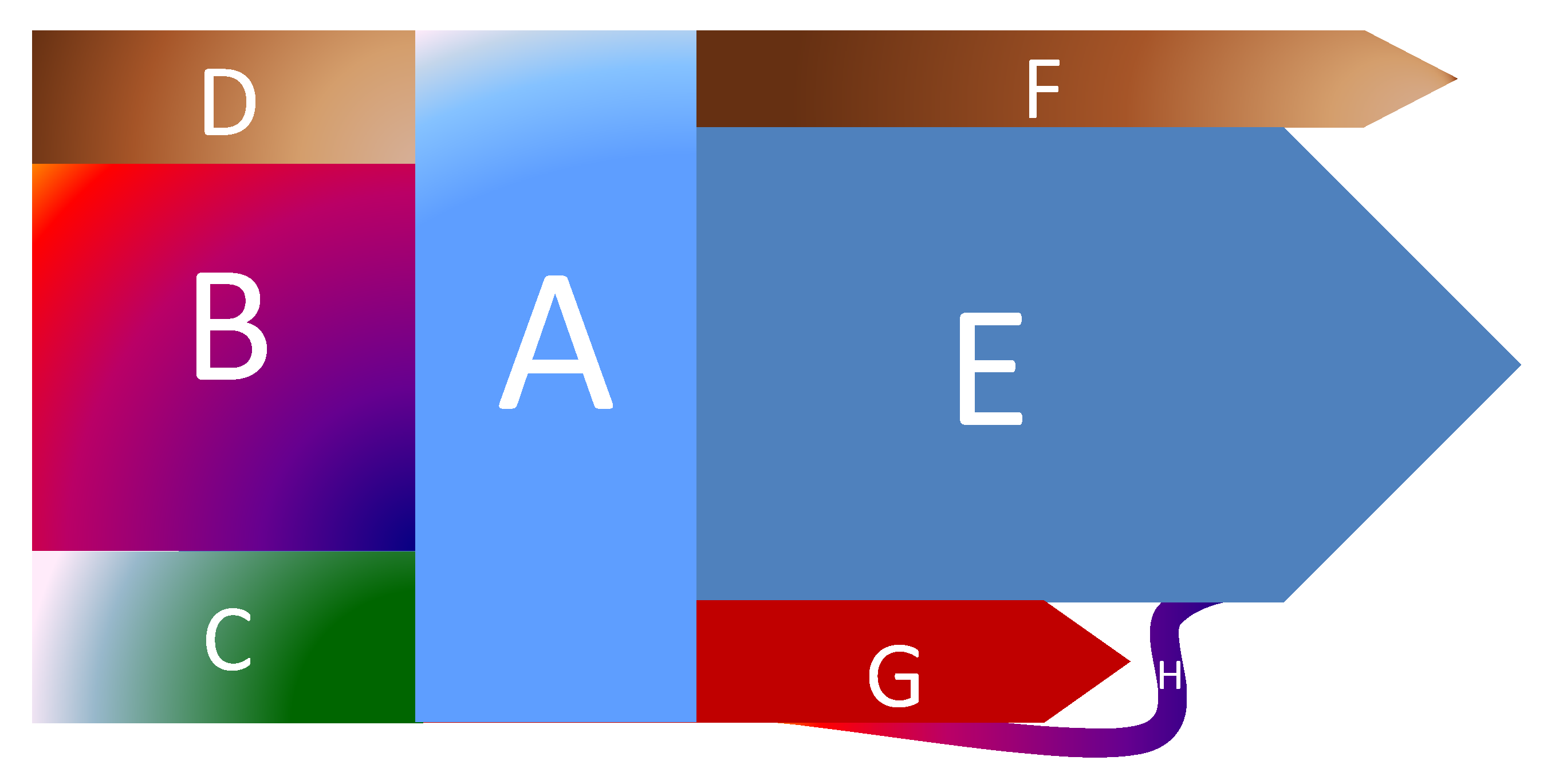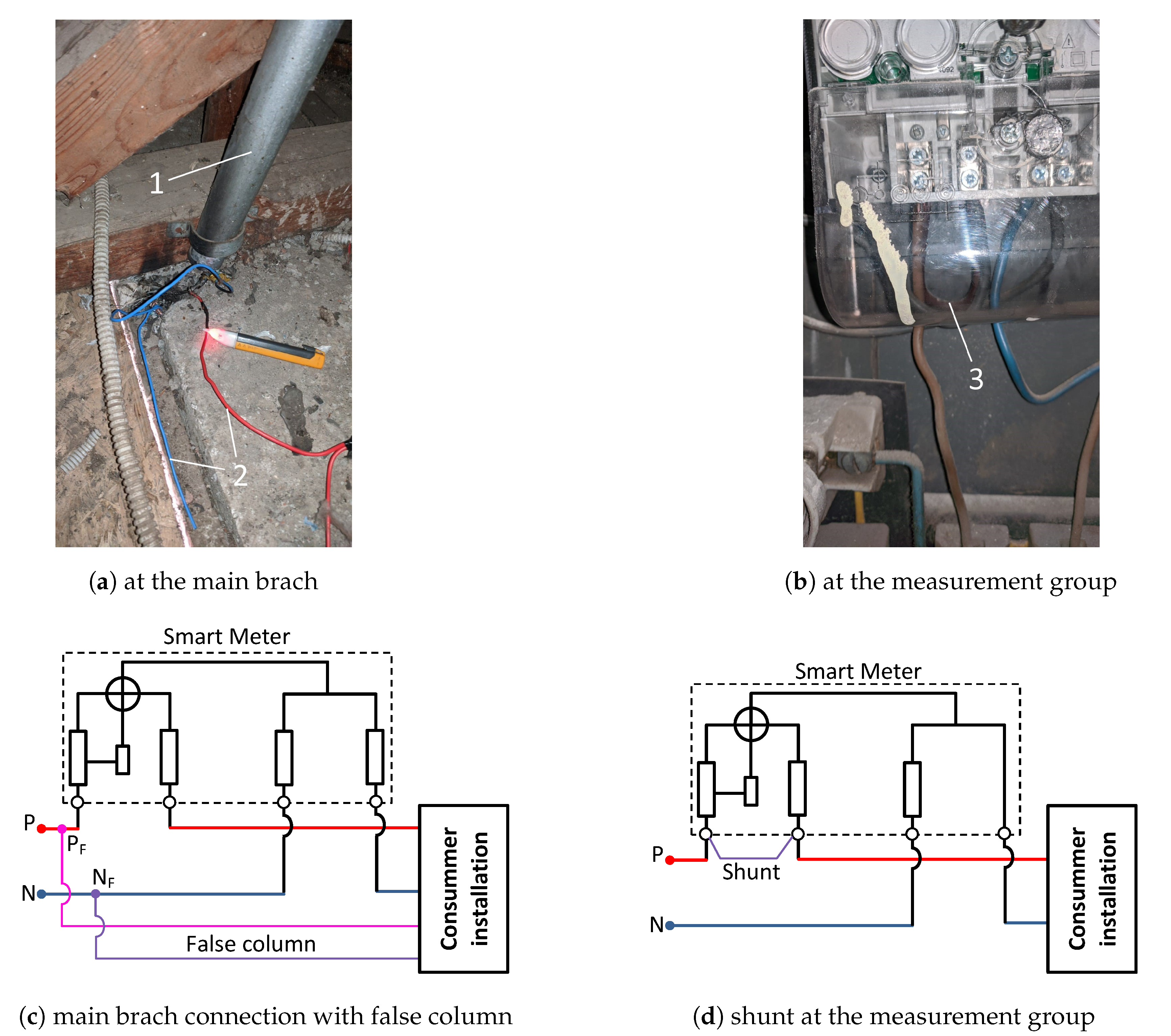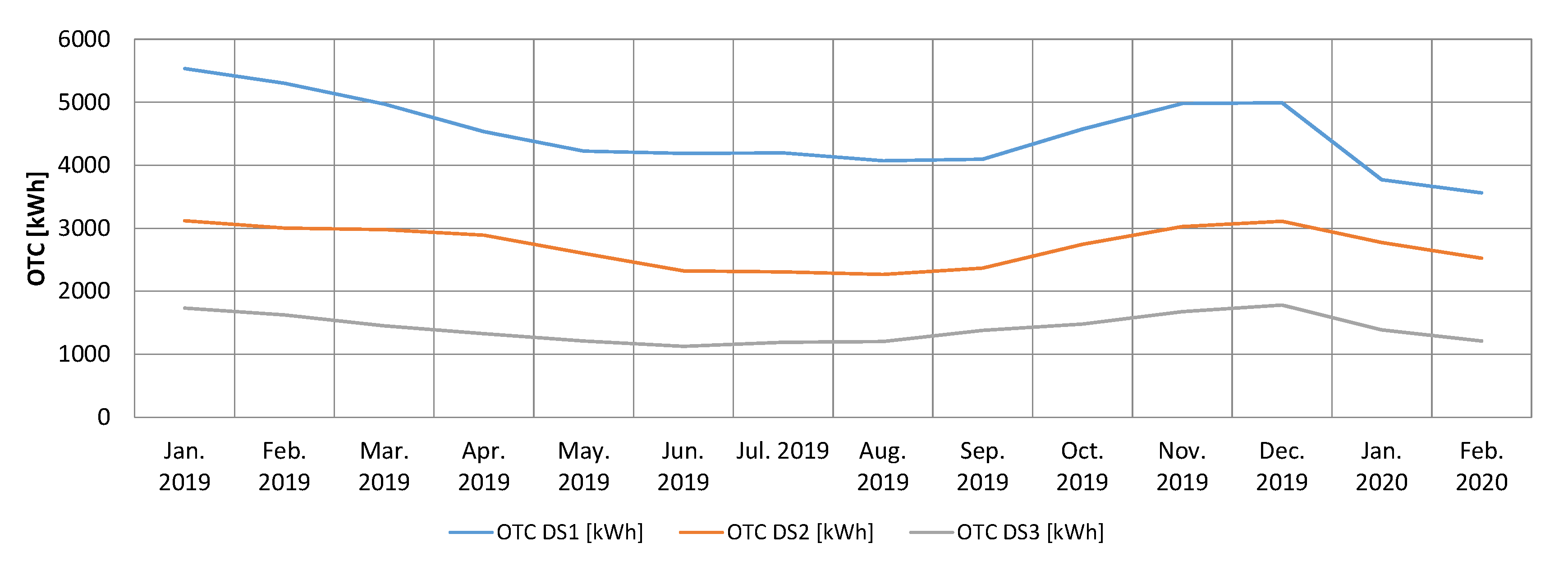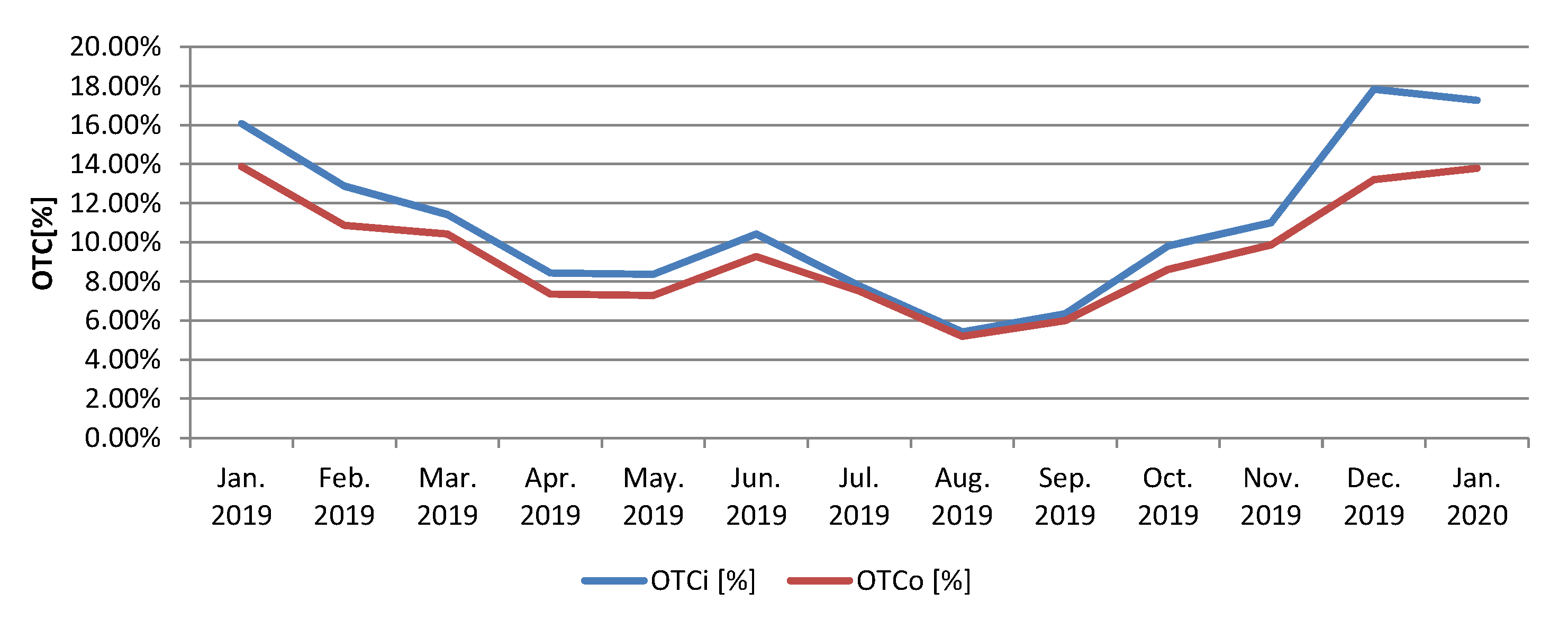1. Introduction
Electricity is one of the most important products of contemporary society, practically making possible the development of many and complex industrial or residential human activities. In order to ensure the efficiency of the production, transport, distribution and use of electricity, it became necessary to monitor and record its parameters as accurate and actual (in real time) as possible [
1,
2,
3]. The interest of stakeholders (producers, transporters, distributors, suppliers and consumers) was also supported by the development of legislation and regulations both nationally and internationally. These refer to programs and directives for the implementation of advanced digital measurements and recording systems of electricity. For example, at the EU level, directives such as 2009/72/EC [
4] or 2019/944 [
5] are well known and regard the development of the internal energy market, with an emphasis on ensuring high standards of providing the services in this field, important being in this case an optimistic coverage of at least 80% of consumers with intelligent metering systems (smart meters (SM)), quantified to almost 200 million such devices as [
6] states. Regulations in the same direction are also met in the US, for example the Energy Independence and Security Act of 2007 [
7], which refers to the modernization of the power system in general and in particular to the adoption of intelligent sensors for measurement. The interest in adopting these solutions shows that if, at the end of 2015, 50% of the domestic consumers were covered (the equivalent of 65 million smart meters), at the end of 2020 the expectation is to reach a threshold of 90 million devices of this type [
8], representing an adoption rate of 67% [
9]. Furthermore, in some countries of the Middle East a policy of developing intelligent metering systems for electricity is implemented. For example, the Islamic Republic of Iran intends that by 2025 approximately 70% of the metering facilities will be upgraded for remote information transmission [
10]. In Asia, in the case of India, the year 2017 represented a milestone for net metering implementation for consumers equipped with roof-top solar system and by 2022 it is intended that consumers from major cities and from some selected urban areas will have the opportunity to chose their electricity suppliers [
11]. Countries such as China and Japan also provide substantial incentives for the use of smart meters, while on the South American continent, part of the Middle East and Africa penetration of smart meters is lower [
12]. As shown in literature, a global appreciation estimates that by 2020 the number of devices integrated into advanced reading systems providing Advanced Metering Infrastructure (AMI) will reach the level of 800 million units [
12].
The adoption of the new systems has been and will continue to be possible due to the development of technologies in the field of information and communications technology, such as Internet of Things (IoT), Internet of Everything (IoE) technologies, etc.
The important feature that intelligent energy measurement solutions offer is the high measurement accuracy (+/−0.2% compared to +/−2% for many of old sensors) due to the high precision current and voltage sensors, by the digital-analog with high sampling frequencies conversion systems and by digital signal processing and processing features for an improved number of functions such as: calculations of all types of energies on the both delivery and receiver channels, load consumer profile or phasor diagrams.
The basic functions of device interconnection also allow the implementation of new features such as the creation of sensor networks, the connection of sensors with databases in the cloud and the development of distributed control systems that can even be based on intelligent algorithms. In this paper we propose the development of a solution that allows to improve the accuracy of the readings of the energy consumption and implicitly the decrease of the technological costs and the increase of the consumers service quality by an invoicing as equitable as possible and early detection of the problems related to the quality of the service or to the quality of the supplied electricity.
4. Smart Metering System Operation Optimization Solution
4.1. Mathematical Model Formulation of the Optimization Problem
The paper intends to develop an optimization solution for identifying the nodes in a system of electricity distribution, in which the consumed energy is not recorded correctly. In this sense, the aim is to develop and solve an optimization model, which is composed of: smart meters, gateways and the physical power support that is used as a communication medium. A series of factors such as: voltage drops in the nodes, data history, anomalies in the remote management systems, the existence of sporadic consumers, differences between the active energy and the reactive energy consumed, which can lead to the identification of the nodes with erroneous energy records were considered in developing the optimisation model. Thus the resulting optimization model proposed by authors is given by the cost function:
subject to:
where:
n—number of transformation stations;
m—number of consumers from j transformation station area;
k—total number of consumers from the analyzed consumption area;
—the metering function precision expressed as optimization vector variable dependence;
—the power failure, term expressed as optimization vector variable dependence;
—the difference between measured electricity and registered in database, term expressed as optimization vector variable dependence;
—the energy difference between reactive and active power.
—coefficient determined based on previous experiences;
—coefficient describing node i degree of connection (connected or disconnected);
—describes a measuring error of power meter between −0.5% and +0.5% in the case of household consumers;
—represents the value indicated by the precision class of the smart meter;
—node i measured energy;
—estimated technical energy loss;
—electricity measured by the general power meter from the transformation station;
—coefficient determined by the voltage drop registration error on each node;
—represents the calculation of the voltage drop in the electrical connection for each node;
—the active power of consumer related to node i;
—the electrical resistance of the electrical connection corresponding to the consumer i;
—the electrical reactance corresponding to the connection of each node separately;
—the reactive energy recorded by each power meter;
—nominal voltage;
—error coefficient of data transfer between the telecommunication system and the data storage system; —the active energy recorded in node i at time t energia; —the energy registered in the database of the billing information system reported at time t;
—error coefficient, difference between the active energy and the reactive inductive energy in a analyzed time interval T.
—the reactive energy consumed, read at time t.
The optimization problem has been modeled starting from the facilities and the multitude of data offered by the remote reading systems implemented so far. The proposed objective is to track real-time energy consumption records from each node, comparing them to general measurement group records.
4.2. Blind Sparky Algorithm for Optimized Operation of an Electricity Utility Smart Metering System
Currently, the identification and correction of OTC is performed by manual analysis consisting in the differences between the energy delivered to the consumer and the one entered identification. This procedure based on the identification of inconsistencies in the energy balance indicates the existence of measurement errors that must be examined and identified individually and manually.
This procedure involves high costs and long time, as well as discomfort for the consumers. In order to eliminate these shortcomings, an algorithm is proposed which, based on the data provided by the smart metering system and a consumption model, will identify the nodes in which problems with the energy consumption or recording are registered.
The conceptual structure of the proposed solution is presented in the Algorithm 1.
| Algorithm 1: Blind Sparky algorithm for maintaining smartmeters’ recordings consistency. |
![Sensors 20 02947 i001 Sensors 20 02947 i001]() |
5. Experimental Case Study
The first step in detecting non-technical losses in a particular area is to foresee an energy balance for that area. If the respective balance is below a theoretical threshold calculated by the distribution operator taking into account the characteristics of the consumption area, then a series of technical measures should be taken in order to reduce the OTC.
An effective measure and without significant implementation costs is the verification of each measurement group in the respective area.
Table 2 summarizes the energy balance data for a community in the Mures County—Romania for the year of operation 2019, before applying the optimization algorithm proposed in this paper.
As it can be seen in
Table 2, in the analyzed network with parameters given in
Table 3 and topology shown in
Figure 3, the energy losses are quite significant, even though the electricity network has been modernized and in the entire locality a PLC (Power Line Communication) system is implemented. The conclusion is that as much of the energy loss can found in activities such as unauthorized energy theft or in problems with some measurement groups.
Blind Sparky algorithm was applied to the entire measurement area, but especially to the power distribution substation areas and , where the most significant energy losses were detected in order to identify fast and in the most accurate way erroneously registered measurements of electricity in certain nodes.
The successfully implementation of the described algorithm is conditioned by an adequate data communication assurance between the devices in the area
and the two data concentrators located in the area of the respective substation. An important factor in the communication endangerment is the large distance between devices and gateway, as well as the harmonic pollution, so to increase the readability of the data, the algorithm described in the paper [
48] has been implemented. Thus the information from the electricity meters located at a greater distance from the gateway is read by using neighboring devices (with the role of repeaters).
After the data acquisition related to active, inductive and capacitive energy consumption, as well as to the events and to the each node characteristic voltages, the data are processed by an application developed in the Python programming environment based on the Blind Sparky algorithm. The application provides for each node the values of the 4th coefficients described in the mathematical model: .
If no anomaly is registered in a node, then the coefficients and the objective function will have the following values:
In
Figure 4 is synthesized the concept of energy contour of an electricity distribution operator, containing the input energy (sections B, C and D, the energy distributed to the consumers (section A), the energy delivered to another distribution operator (section F) and the energy losses (OTC) (section G). Part of the OTC energy can be recovered by identifying the defective measurement groups, this quantity being invoiced according to the legal provisions (section H). Each distribution operator monitors daily the evolution of the energy contour, establishing the forecast of the energy exchanges for the next day and trying by using the methods described in this paper to reduce the technical losses, but especially the non-technical losses. An important element in balancing the energy contour is to increase the amount of recovered energy and to stop the losses of electricity from unauthorized interventions.
In the case of an energy meter corresponding to a node with a measurement error greater than the threshold imposed by the legal measurement rules, then the value of the coefficient will be greater than the unit and the value of the objective function will be greater than zero. There are many situations, especially in the disadvantaged areas, where certain consumers, after being disconnected from the electricity network, will connect themselves back illegally. In these situations, the consumed energy can’t be invoiced and the index from the telemetering system will be different from the index registered in the billing system (). The classic methods used to bypass the electricity meter, by false columns or shunts made under the terminal cap of the meter, will be detected by following the changing values of the coefficients
The algorithm described, based on the recorded data related to the consumption and on the technical data corresponding to the electrical network, calculates the value of the voltage drop related to each node, by using Equation (4):
where:
i—the number of connection point on given branch;
—electrical resistivity of the power line;
—length of the main electrical cable on a section;
—section of the main electrical cable;
—active power;
—reactance of the main electrical cable;
—reactive power;
—nominal voltage;
—electrical resistivity of the branch;
—length of the branch;
—section of the branch;
—reactance of the branch.
The obtained values are compared with the values recorded by the smart metering devices, so if a big difference is recorded between the two values, then in the respective node a suspicion of incorrect registration can be reported. In the case of false columns in most situations the inductive energy passes through the measurement group so the energy recorded on the 1st and 4th quadrants will be higher than the active energy recorded.
By applying the Blind Sparky algorithm on the analyzed measurement area, a series of irregularities were detected in some measurement groups, from meters with precision class malfunctioning, to well masked illegal installations mounted before the electricity meter, as presented in the
Figure 5a,c which are dangerous for both the distribution operator and the consumer. Unauthorized installations do not comply with any norms from the point of view of fire prevention and extinction, as well as from the safety of the operating personnel. A more subtile method of stealing electricity is the one shown in the
Figure 5b,d which consists of inserting a shunt between the input and output terminals of the electricity meter.
The Blind Sparky algorithm is able to detect this anomaly as well as the situation in which one of the consumers illegally reconnects to the electricity grid.
In the measurement area in which the algorithm presented in this paper was tested, four cases of possible fraud were detected as shown in
Table 4, which were confirmed by an on-the-spot verification by the personnel from the distribution operator, in total being recovered an amount of 11,282 [kWh] according to the norms imposed by NERA (National Energy Regulatory Authority).
In the
Figure 6 is represented the evolution of the OTC, on three power distribution substations considered representative in the measurements analysis area. After the implementation of the described Blind Sparky algorithm, a significant decrease can be observed in the amount of OTC energy corresponding to the three power distribution substations. The implemented algorithm uses all the facilities offered by the electricity measurement sensors in each node, thus any anomaly related to the precise measurement of the electrical energy is instantly detected. The energy input and consumption of each node is reported every 15 min to the central system by the measurement sensors attached to each node, so the energy balances are updated continuously, any anomaly being detected in real time. The graph in the
Figure 7 shows a decrease of about four percent of the OTC for the entire measurement analysis area, related to the total amount of distributed energy.
The Blind Sparky algorithm can be implemented on a much larger scale than the situation presented in this paper. It can be extended to all areas within the SDEE Mures where the intelligent measurement system is implemented. In the hypothesis that all the power meters within SR Mures would be able to provide real-time data for the implementation of the algorithm described in this paper, then there would be the possibility that the value of the OTC would decrease from approximately four percentages during the colder seasons to approximately two percent in the spring-summer period according to
Table 5.
Energy forecast to be recovered throughout 2019 out of a total of approximately 156,000 MWh of losses reaches 1560 MWh.
In
Figure 8 is presented the comparative evolution of the recorded losses and of the losses resulted after optimization as a result of the sources of losses identification through the proposed algorithm.
6. Conclusions
Reducing the technical and non-technical losses of electricity is a priority for the power distribution operator motivated by the need to operate and provide the services under conditions of energy efficiency, economic competitiveness and compliance with national regulations and international standards.
Apparently less visible, the reduction of non-technical losses in the low voltage networks brings a financial benefit to the distribution operator, but also a significant improvement of the quality of the distributed electricity by adapting the consumption to the real needs and the projected capacity of the electricity supply system.
In this paper, a new algorithm for identifying locations with significant non-technical losses in a power distribution grid manifested in the form of incorrectly counted electricity is proposed. The proposed solution in this paper, called Blind Sparky, starts from an optimization algorithm that identifies the nodes with energy losses through the smart metering system. The proposed model includes multi-criteria aspects related to technical measurement errors and incidents, respectively non-technical ones, coming from altering the operating mode of the measuring systems in order to correctly bill the consumed electricity.
To validate and highlight the performance of the proposed algorithm, it was tested in a locality with 198 nodes within SR Mures. The results obtained in the test configuration illustrate that in a smart remote management system, by applying the proposed algorithm the non-technical losses can be significantly reduced, which leads to a significant improvement of the OTC especially during the winter period, when the fraudulent consumption of energy increases significantly. After the application of the Blind Sparky algorithm, some nodes where the electricity was not metered correctly in the presented configuration were identified, so after a spot check of the consumers indicated by the algorithm, a series of irregularities were detected and were remedied, being recovered, according to NERA norms, an amount of approximately 11 MWh, which reaches of the total energy losses in the respective locality.
The algorithm presented and tested in the paper being validated for a single locality where smart remote management system is implemented, but the proposed solution can be extended as a functionality for the entire topology of low voltage networks within SR Mures. In this case the calculations show that there is the possibility of recovering non-invoiced consumptions around 1560 MWh which represents of total losses related to the registrations for the year 2019.
Implementations of the smart metering systems brings many benefits from the consumer point of view such as more precise billing, flexible billing programe or awareness of the electricity consumption. However, significant benefits arise also for electricity distribution companies towards improving the quality of service and, if evaluated from the current work goal point of view, smart metering systems constitute base framework support for real-time monitoring solutions needed for high quality of the electricity delivery along identification of the non-technical losses sources.
